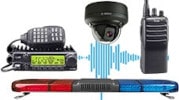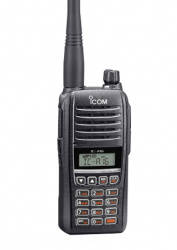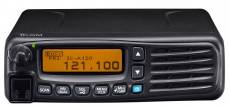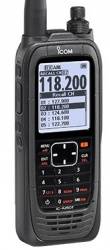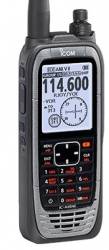Aviation Radio
- further categoriesSince the beginning, aviation and radio have gone hand in hand. At altitude, there has always been a need for efficient and rapid communication, which is most easily achieved by this technique. Nowadays, clear standards and modern tools are available to help professional and amateur pilots and ground crews. Also known as re-band radios, they can do much more than just provide two-way communication. Read more...
• VHF airband radio
• Maximum 9W RF output power (carrier power)
• Full dot-matrix LCD display
• Active Noise Cancelling (ANC)
• Confirms with IP54 standard (dust-protection and water resistant)
• Dualwatch and on-hook scan functions
• 200 programmable memory channels
• Optional Bluetooth panel
• 8.33kHz / 25kHz dual channel spacing
• Equivalent to MIL-STD 810 C, D, E, F and G requirements
• The radio doesn't have TSO certification!
• VHF airband radio
• Maximum 8W RF output power (carrier power)
• Large, bright OLED display
• Easy channel selection
• Slim type construction design
• Side tone function
• Intercom function
• 100 programmable memory channels
• 8.33kHz / 25kHz dual channel spacing
• Equivalent to MIL-STD 810 C, D, E, and F requirements
• The radio has TSO certification!
• This new version will be available by the end of August!
• VHF airband radio
• 1500mW loud audio provides clear communication
• Output power: 6W (PEP), 1.8W (carrier)
• 8.33kHz / 25kHz dual channel spacing
• Full keypad
• Easy to use while flying
• 200 programmable memory channels, 10 memory banks
• Side tone function, ANL Auto Noise Limiter, built-in VOX function
• Confirms with IP67/54 dust and water resistant protection
• Equivalent to MIL-STD 810 C, D, E, and F requirements
• LCD and key backlight for night time operation
• BNC type antenna connector
• VHF airband radio
• 1500mW loud audio provides clear communication
• Output power: 6W (PEP), 1.8W (carrier)
• 8.33kHz / 25kHz dual channel spacing
• Full keypad
• Easy to use while flying
• 200 programmable memory channels, 10 memory banks
• Side tone function, ANL Auto Noise Limiter, built-in VOX function
• Confirms with IP67/54 dust and water resistant protection
• Equivalent to MIL-STD 810 C, D, E, and F requirements
• LCD and key backlight for night time operation
• BNC type antenna connector
• VHF airband radio
• COM channels
• Maximum 6,0/1,8W RF output power (PEP/carrier)
• 8.33kHz / 25kHz dual channel spacing
• Large, alphanumeric LCD display
• Full keypad
• 300 programmable memory channels / 15 groups
• Confirms with IP57 standard (dustprotection and waterproof protection) (1 meter depth for 30 minutes)
• Basic package include: BP-288 Li-ion battery, BC-224 rapid charger, FA-B02AR antenna, MB-133 belt clip, handstrap (no BP-289 battery case, no OPC-2379 headset adapter cable)
• VHF airband radio
• NAV+COM channels
• GPS and Bluetooth functions
• Maximum 6,0/1,8W RF output power (PEP/carrier)
• 8.33kHz / 25kHz dual channel spacing
• Large, alphanumeric LCD display
• Full keypad
• 300 programmable memory channels / 15 groups
• Confirms with IP57 standard (dustprotection and waterproof protection) (1 meter depth for 30 minutes)
Aeronautical frequencies
108.000 - 136.975 MHz
The full rep band used in civil aviation, including small and large aircraft, business and private traffic.
108,000 - 117,975 MHz
The civil aviation range for navigation purposes (NAV).
118,000 - 136,975 MHz
The COM, or communications range for civil aircraft.
Military frequencies
The frequencies used by the armed forces are located above the civilian frequencies. These frequencies are typically secret and civilian radios are not able to receive these ranges.
121.5 MHz
International emergency frequency. Search teams use the radio signals transmitted on this frequency to locate a distressed aircraft. Accordingly, it is only to be used in case of emergency. Some radio repeaters can be set to transmit automatically to ensure that the distress signal is broadcast continuously.
255 - 495 kHz
Frequency of the route direction finder (NDB). Not to be used for verbal communication.
108 - 111,975 MHz
Instrument Landing System Direction Finding (ILS LOC). Not to be used for verbal communication.
What should be considered when buying an airband radio?
Portability
We offer a range of handheld, desktop, car and small aircraft radios. All of these types require a radio licence to be used as a radio transceiver (our company will be happy to help you obtain a licence). The desktop ground-to-air radios are ideal for installation in control panels or in vehicles due to their external antenna connection. Hand-held radios are typically available with display and in full pocket design.
Ease of use
Modern radios are not particularly complicated to use and offer a range of convenience features to help users. Most models allow hundreds of channels to be stored and wireless headphones can be connected via Bluetooth. Large displays make it easy to keep track of key information, and advanced Li-Ion batteries allow for extremely long battery life.
Extra features
Before you decide, you should also consider what extra features you need. These could include a slim design or intercom functions. The built-in GPS is a very useful addition for any aircraft, as is the VOR function, which also plays a role in positioning. The active noise reduction available in some models and the increased speaker power allow even more precise communication.
Consult a professional if you are considering a radio with a flight band. Our company will help you with everything from licensing to equipment purchase and installation.

